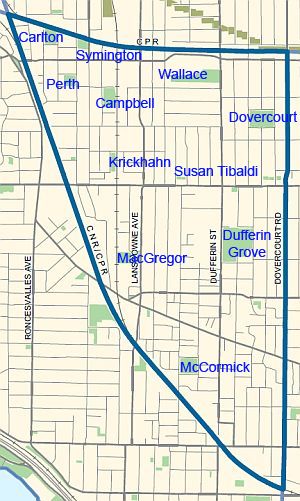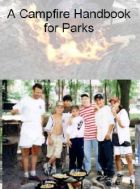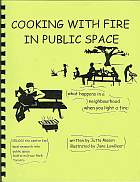

Pages in this Folder:

Related Folders:
See also Department Site Map
Support Provided by

Toronto Parks and Trees Foundation

This website has received support from celos.ca through the Trillium foundation.
Publications
Comments?
For the basics, see
- Website & Privacy Policies
- How To Get Involved
- The Role of the Park
Search options:
Department Site Map
Custodians:
< Chapter Twenty-eight | Stories List | Chapter Thirty >
Spring Story

The Ward 18 Parks Conservancy: a map
The remaking of Toronto parks:
A summer-fall-winter serial, continuing into spring, March 15, 2012 Chapter Twenty-nine
By: Jutta Mason
How much can a neighbourhood learn about building up small-scale local democracy? That was the question on the final page of Chapter 28. This chapter is the first in the fourth and final season, spring. The series began as the story of the unmaking of the “community centre without walls” that developed over 18 years at Dufferin Grove Park. Then the story branched out into other parks and the larger picture. I described how the management of Parks, Forestry and Recreation (PFR) has mapped out a radically different direction for our public spaces, increasingly carving them up into commodities offered for rental to whoever will pay. But taxpayers have already prepaid. Can Ward 18 taxpayers take an alternative direction, working with on-site city staff, to restore our neighbourhood parks to being lively, open-access, all-ages community gathering-places? To consider how this can happen, we start today with a map that sketches out the parks in this neighborhood.
Ward 18 is shaped like a wedge, with the thin edge reaching just below Queen Street, east of Dufferin, and the top extending up to the railway tracks north of Dupont Street. We’ll start our mapping at the south.
Lisgar Park: Charles Campbell and Michelle Gay, members of “Active 18,” are part of a residents’ group concerned with appropriate development in the Queen West area south of the Gladstone and the Drake Hotels. In a recent “conservancy” conservation they talked about the possible kinds of activities in their soon-to-be park, which is at the centre of massive new developments. Right now the park is just a parking lot for construction vehicles, but the plan for a green commons is ready to go. They’re pondering park seating, maintenance, and diverse local uses that will encourage acquaintance among the many new tenants. “No big stages!”
Osler playground, on Argyle Street. At the end of the 19th century, this was a hugely popular playground for working-class children, one of the first playgrounds in immigrant Toronto, donated in the 1880’s by the banker Sir Edmund Osler. It has a big play structure that has a lot of graffiti, inspired by the structure’s flesh-coloured tube slides. Can some of the park’s programs be revived to provide outdoor occasions for neighbourhood friendships in this fast-changing part of Ward 18?
St.Clarens Parkette: Helder Ramos, co-ordinator of the Dupont West Business Improvement Association (“DuWest B.I.A.”), says this little parkette was set up by the business association years ago, at Dundas and St.Clarens. He said the park has become a bit of an orphan, since volunteers got tired of cleaning up the litter and tending the flowerbed. There’s a little playground, but he almost never sees any children playing there. How can the little park, across the street from graceful old St.Helen’s church, become less of a night-time hiding place for lost souls and more of a neighbourhood gathering place?
MacGregor Park: this old park along the railway tracks on Lansdowne north of College was always full of kids until the 1990’s. Then it emptied right out, as the children of the first waves of immigrants grew up and moved away. But in the past five years it’s had a wonderful renaissance. One reason is the work of artist Kristen Fahrig, who lives three blocks away and applied for funding from all three levels of government to let her be the MacGregor Park “artist-in-residence.” Kristen works with the more recent influx of children and their families, who were attracted to the area by the last downtown pockets of affordable housing. Ward 18 city recreation worker Anna Galati, who lives across the street, has built on Kristin’s work by drawing in neighbours and restoring some city programs.
The solid old MacGregor wading pool has been the main draw during summer.
Kristen built close relations with the adjacent high school, and got funding to help students (many of them refugees from Tibet and Eastern Europe) build and paint some spectacular benches and picnic tables for the wading pool area. Two years ago, the handsome-but-leaky old field house beside the wading pool somehow got on the city’s Stimulus Funds list. Wonderful! Despite an initial reluctance by city staff to allow community input in the planning of repairs, eventually over $140,000 was spent to make the field house a useful staging area for the expanding summer wading pool activities and other park programs. Gardens have been put in by both the city and volunteers, and there have been many community campfires and seasonal festivals.
Kristen said she couldn’t believe it when she read that city management put MacGregor wading pool on the November budget list of five “underused wading pools in need of expensive repairs” that could be closed to save money. She said that if the wading pool closes, the park’s heart will be removed. City Council voted YES for the closure. So one of the first campaigns of the Ward 18 Parks Conservancy will be reversing this false economy.
Wasting resources that we already have, by locking them up, is a very common process at parks citywide. Making good use of what we have is one of the principles of the conservancy.
McCormick Park has a playground, wading pool, and games area in the south half of the block that has Mary McCormick Recreation Centre and McCormick Arena. A park friends group is just starting up here, and a conversation about the conservancy is planned.
Dufferin Grove Park: this park is essentially already a kind of conservancy, which grew up over the past 18 years through collaboration between many different players – across a permeable line between city staff and community park users. The Dufferin Grove “conservancy” was never very energetic about applying for grants, but even so, over that 18 year period, staff and park friends got about $530,000 in grants for various park projects. In addition, over the last eight years, the Dufferin Grove “community centre without walls” gradually increased its annual city allocation to about $250,000 a year for program funds. Other costs are a yet-undisclosed amount for park maintenance including of the rink, and a rapidly increasing amount, also still undisclosed, for administration. Even so, the cost to run Dufferin Grove Park is unlikely to equal the cost to run an ordinary community centre with walls: between $1 million and $1.5 million a year.
Requests to the city every few years, to designate Dufferin Grove Park as a kind of laboratory for trying things, were never approved. Despite this, the park is publicly known as a lab de facto, with collaboration from CELOS, the “Centre for Local Research into Public Space,” a little research group which was incorporated in 2005 and got its charitable number in 2009. Support for the extra work of trying new things came from the gradual rise in donations for food and, later on, skate loans. Since 1998, upwards of $1.5 million has been raised for Dufferin Grove (and other ward 18 parks) “lab experiments” through those donations.
When it became obvious that the food and skate donations were a good and low-cost way to enliven a park, the question became, how to get the city to integrate, into city practices, approaches that worked well. As many readers of these chapters know, although the city did take over more of the staffing and CELOS began transferring more of the donations back to City directly (about $27,000 since last May), collaboration has been stymied. And the new layers of administration from PFR management added so much local work and worry that the net donation-revenue shrank.
Getting a clear view of finances is fundamental for setting up the conservancy. CELOS has sent city management a request for the detailed budget lines of all Ward 18 PFR programs. Other financial information, collected from various freedom of information requests, is going up day by day on the public commons website. The same information will be posted at the playground and by the rink clubhouse, as soon as all chance of snow is over.
Anne Shaddick, one of the pioneers of the early additions to the park, reminisced about the playground fence that parents asked for in the 1990’s, when the dogs were scaring the children. “Do you remember that the city was going to put up chain link? And the parents just said, No!! That’s how we got farm fence that’s there now. We know what we want. And it’s not extravagant.”
Susan Tibaldi Parkette: this is a small playground bounded by some flowerbeds, on the subway lands between Brock and Emerson Streets. The parkette is named after a former head of the Bloordale Business Improvement Association, who tried hard to rescue the faltering businesses along Bloor Street after the subway took away much of the surface foot traffic in 1973. About four years ago, park neighbours Helen Acraman and Catherine Shepherd started setting up campfires and cookouts and summer evening potlucks at the parkette. They were trying to ameliorate the culture clash that happens in a neighbourhood when cheap bars and drug problems run up against an influx of young families. The residents’ group Digin (Dupont Improvement Group) has the same objective over a larger area that has Lansdowne and Bloor as ground zero, its efforts ranging from getting more police action, to encouraging public art, to boosting local business.
Dovercourt Park: This is the second-largest park in Ward 18, surrounded on all four sides by quiet residential streets, with the recently-expanded Dovercourt Boys and Girls’ Club in the northeast corner. Park neighbour Andrea Dawber says that the many new trees that were planted there over the past ten years are now thriving, through community efforts working in step with the city. Two city staff living across from the park taught Andrea how to get access to little-known grants, to pay for the park’s concrete entrance features and the iron fence around the playground. Andrea’s tree advocacy has expanded far beyond Dovercourt Park into three other wards through her agency “Greenhere.” As long as developers have to pay extra money for any deviation from the city plan, Andrea pointed out, there will be funds to make other entrance features, and add better trees and plantings, for example at subway-land parks like Westmoreland park (the strip behind the Dovercourt ambulance station). Greenhere has invited corporations to send over volunteers (“alpha personalities,” Andrea jokingly calls them), passing through the neighbourhood in energetic teams that mulch great numbers of new trees and thus help preserve the recent plantings.
The Railpath linear park: Gabrielle Langlois (Davenport-Perth Neighbourhood and Community Health Centre, DPNCHC) is working on a mid-June bike festival along the railpath, which will involve various local agencies (and the Dufferin Grove Park food cart too). Scott Dobson, a long-time member of the Friends of West Toronto Railpath, said that collaborations of all kinds are what will make the railpath flourish. His group has been letting the fruit harvesting organization “Not Far From the Tree” use the railpath park shed for storing some of their harvesting bikes for the winter. The railpath friends are focused on extending the railpath downtown and further to the north, along the ample land allowance beside the rails – and on not having the park overcome out by the fumes of diesel trains.
Erwin Krickhahn Park, north of Bloor along Rankin Crescent, resulted from the efforts of a former East German railway engineer who immigrated to Canada in the 1960’s and got sick with Lou Gehrig’s disease (ALS) in the 10980’s. For years, Krickhahn lobbied from his wheelchair for the transformation of a vacant lot into a park, but the issue was fiercely divisive from the beginning, with some neighbours absolutely rejecting any park because it might attract misbehaving youth. The park was put in anyway, along with more single-family housing. Krickhahn lived just long enough to see the park plantings get underway, but the place never quite lost its vacant-lot feeling. When Councillor Adam Giambrone arranged for a community garden to be put into the middle of the park ten years later, and got a garden fence installed, neighbourhood activist Jack Fava organized two large meetings that brought the underlying culture clash to the surface again – long-time Portuguese and Italian residents versus new homebuyers with young families and different ideas, all of them filmed by City TV news. The fence was removed, the garden soil recovered with sod, and the concrete-bunker garden shed was trucked off to Symington Park instead.
Giambrone next got the city to close a small stub of Paton Road abutting the north end of Krickhaan Park. The stub dead-ended at a high stone wall separating the railway tracks from the neighbourhood. Giambrone wanted the asphalt removed and the community garden located where the street had been. But again angry resistance flared up again and the garden was not put in.
For some years a break in the chain link fence between the park and the railway track has given access to a few tent encampments partly hidden in the scrub Manitoba maples on the railway side. This park could use some delicate Conservancy attention, because at times it gives the impression of a scrubby, neglected borderland.
Perth Park abuts north of the combined Catholic “St.Luigi” and public “ Perth Avenue” primary schools. There are photos in the City archives that show hundreds of spectators watching baseball games at the park in the 1920’s, even though the playing area was pretty small. There must have been some broken windows across the street, the same houses that are all still there. Brenda Heyer, a park enthusiast whose child goes to the school, said that parents often bring a potluck supper over to the park late Friday afternoon on warm May and June days, to prolong the outdoor pleasure of the long days. There’s a good-sized, solid washroom building in the park, which was closed for several years until Brenda lobbied Councillor Bailao to have it reopened. Picnics and playground visits go better if park users don’t have to go all the way home to use the bathroom, like they do in Etobicoke parks (almost none of them have washrooms). What’s still missing at Perth Park is picnic tables. Brenda says: is it really so hard to give each park four or five picnic tables?
Campbell Park is much younger than Perth Park. It was added at the end of World War Two, to give a bigger space for working class families to play baseball in summer and skate in winter. These days it’s filled with young Toronto Eagles soccer players in summer. There’s a recently upgraded wading pool, and a playground. In winter the compressor-cooled ice rink draws skaters from all over the west end. Last year Councillor Ana Bailao found funds to put kitchen plumbing into the rink clubhouse. That allowed city staff to work with neighbourhood youth to start Saturday Night community suppers. Both staff and park users want the suppers to restart in spring and summer, but PFR management made cuts to staff program support for parks. Here’s the budget item: P.28 The 2012 Recommended Operating Budget for Parks, Forestry and Recreation includes savings of $0.175 million as a result of harmonizing recreation support in Parks Branch and eliminating 5.2 temporary position equivalents. Cutting the equivalent of 5.2 part time program staff for park locations will save $175,000 out of a total 2012 operating budget of $377 million. The cheapest on-site part-time recreation staff are easier to cut than the many full-time staff who earn between three and six times as much, but whose jobs no longer involve direct park or recreation centre program work (their jobs were changed to administration).
Here is the PFR explanation for these particular cuts: This recommended minor service level change will harmonize recreation support provided in City's parks by having community event organizers rely more heavily on volunteers or collect special event support costs. There are to be no city staff made available to help. The volunteers will have to do more than just work with the youth to cook the dinner, though – they’ll have to pay a permit fee of $76 dollars each Saturday to use the clubhouse, plus buy $2 million of insurance. Much of the clubhouse kitchen equipment was paid for with funds raised from neighbourhood donours, but now the city proposes to charge the community for using what it helped create. (The same situation exists elsewhere in the city, for instance at Sorauren Park field house).
The Parks Conservancy will help Campbell Park users create different rules, since the charges levied by the city will shut down community dinners, but park users want them to thrive.
Carlton Park is at the very north end of Ward 18, abutting the main east-west railway line. It has a wading pool and a playground and basketball courts, but no washrooms and very few picnic tables. In summer, wading pool staff have to use a park neighbour’s washroom. Nevertheless the park has ample space for kids to run around, and lots of shade trees, so neighbours like to gather there in hot weather. Brenda Heyer hopes to have a community campfire at Carlton Park in spring. Campfire support is also threatened by PFR’s attempt to “harmonize” staff program support downwards. Park friends in the east end of Toronto have been asked to pay over $100 each time they want a community campfire – but the Ward 18 conservancy will steer in a different direction.
Symington Park also abuts the northern railway boundary. It’s east of Carlton Park. It has free, newly-paved tennis courts and a wonderful community garden. There’s a big concrete pad, left over from when the park was a storage yard for park maintenance crews. Parents take their little kids there to ride their scooters or their trikes, but there’s only one small bench for parents to sit on. Neighbours say that the park used to be deserted. Since the garden was established and the tennis courts were repaved, there are always people in it. The conservancy will help build on this revival, with community-built benches.
Wallace Park is a narrow strip to the south of Wallace-Emerson Community Centre, bending around the rink. It has soccer fields extending along the south end of the shopping mall parking lot. In winter the double-pad compressor-cooled skating rink is filled with people, now that a little rink clubhouse kitchen was augmented by Councillor Bailao’s intervention at Wallace (as well as Campbell) clubhouse. For years, volunteer Mike Heaton set up a BMX track on the rink pads in spring-summer-fall. PFR has not yet worked out a way to help support this popular amenity, so this year it may not happen. Wallace Emerson has also had a kind of conservancy over the years, growing out of an indoor park that began in 1984. The section of park directly outside the rink was the site of a drug-related murder in the summer of 2004, and since that time, community-staff efforts to reclaim the park and the rink got steadily stronger. Local artist and neighbourhood-booster Dyan Marie raised funds years ago to add some public art and better pathways to the park. DigIn, the Dupont Improvement group, has monthly meetings overlooking the park. The conservancy will explore ways to build on what has already been accomplished there.
Spring is a time of renewed possibilities, including the chance that the long-running project of enlivening local parks in Ward 18 can be put on a solid footing. To get from the de facto conservancy to the de jure kind, Ward 18 Councillor Ana Bailao will need to make a proposal to her colleagues.
So the past two weeks have been taken up with a great many conversations about the parks conservancy, and how it might look. There will be many more such conversations in the neighbourhood – every contribution welcome, and noted, to gradually knit together the structure to recommend to the councillor. If Ward 18 is to dodge the city’s aim of renting public spaces back to the citizens whose taxes paid for them in the first place, that can best be accomplished through such friendly conversations.
Winter Story (2012) is published by the Centre for Local Research into Public Space (CELOS), www.celos.ca.
Illustrations by Jane LowBeer






 Printer friendly version
Printer friendly version